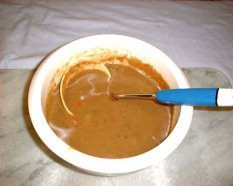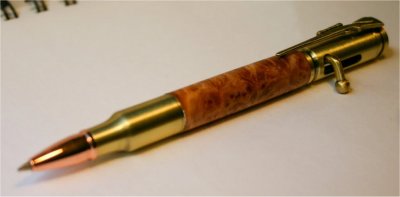Bil Wight’s Paste Food for Koi and Pond Fish
Some ingredients, like the seaweed flour, can be difficult to obtain, but if you persist, you can get lucky. when I bought the flour for the first time, because the animal feeds dealer had to buy a 25 kilo sack, which no-one else wanted, I bought the whole sack, even tho I figured it would take a couple of years to use it all. Ahaha. It lasted less than a season. Seaweed flour is a huge improvement on wheat flour for binding. It isn’t so downright fattening, it boosts the amount of algal proteins/amino acids, and it adds trace elements. 3 for the price of 1, as it were. It does need to be very fine, like flour. Granular seaweed won’t bind, messes up the consistency of the mix, and isn’t digested well by the fish.
Bil Wight’s Paste Food for Koi and Pond Fish
The amounts and ingredients are all variable, and can be adapted to what you have available. All the information, while as accurate as possible will not all apply to every pond, and common sense should be used in interpreting it.
The recipe is the way it is for a lot of reasons. It started off quite simply, and then like Topsy, it grew. It has had a lot of the corners knocked off by now, simply thru trying it and correcting mistakes a bit at a time over the last few years. Usually what happens is that the first thing people say is “I won’t bother with that, this isn’t necessary, and these would be be better.” They then mail me and say they are having problems with the recipe. It clouds the water really badly, won’t stay together, causes this problem or that and so on ad infinitum. What I would suggest is that no matter how stupid, unnecessary or silly you think some details are, make one batch exactly as I say. After that by all means experiment, and if you find something that works better, please let me know.
As time goes by, this ‘recipe’ is bound to change further, so feel free to mail me and ask for an update. If you are going to feed at cooler temps, the following should be borne in mind. Make sure your biofiltration is excellent, rather than adequate, and test regularly to ensure that ammonia or nitrite isn’t building up. Large females that are building up egg masses are best starved for some of the winter to reduce the risk of their becoming egg bound. However, the usual winter period where they show no interest in food is probably well in excess of this, and the average unheated ponder is unlikely to need to worry about that.
This recipe is aimed at the average hobbyist, to provide a good all year round food which needs no great variation. It does not claim to be “The Ultimate”, or even to be complete, in the sense that it is guaranteed to contain every single element essential for growth. It does try to come close, and it does offer you the opportunity to manipulate and alter the mix. This paste food is an attempt to give the koi a similar quality and variety of foodstuffs as it would find in the wild.
For a food strategy for those who wish to take it that bit further, please see the second part of this ‘recipe’.
Without a doubt, live food is the best. Feeding even a small amount of live food on a regular basis produces results out of all proportion to the amount fed. It is often rich in some of the amino acids and other substances that can be scarce in pelleted food, and this can enable the fish to make better use of the other food you give them. A wider variety of proteins, and hence amino acids, means better use of proteins for growth, and less waste amino acids meaning less ammonia for the filters to deal with. Woodlice, worms, spiders, grubs, centipedes, the list is almost endless. Avoid maggots, mealworms, millipedes and adult beetles, and it is wise to crush the “head” of anything like spiders or beetle grubs which could bite the fish’s mouth, and possibly put it off these valuable foodstuffs. Live freshwater foods should be avoided due to the risk of transferring parasites. Remember that some parasites are not removed by washing and cleaning, but are embedded in cysts deep in the tissues where they wait for their host to be eaten. For this reason anything that lives in water – salt or fresh, should be cooked thoroughly before feeding it to the koi.
Dried insects can be bought from bird food suppliers as an excellent dietary supplement. If you have some spare space in your garden, give some serious thought to providing refuges for invertebrates. If you have the space to run a small compost heap, and you put plenty of cardboard on it to mix and rot with the household vegetable waste, you will encourage woodlice and all sorts of other creepy crawlies. I try and make sure there are lots of old tiles and so on leaning in small stacks against the sides of the compost and elsewhere in the garden.
This provides them with good, safe homes and increases the biodiversity in the area. Plus, you increase the population which you can then harvest in a sustainable fashion for your fish.
Prawns are a great treat, but pull off the ‘heads’ and remove the shells. 3 reasons; the heads have a sharp spike, (the rostrum), they make a mess in the water and the carapaces get spat out and lie on the bottom. Save all this for the recipe. Cut the prawn tails up and feed all year round, especially in the winter AS LONG AS THEY WILL TAKE THEM.
Don’t give them the washed out shell less prawns from the freezer cabinet. They really need prime protein and oil, and shell on prawns provide this. (Note. Do not thaw them aggressively with warm or hot water, as this will drive the oils out of the prawn tissues, which is a waste). Plus, you help to keep the filter fed, so hopefully you won’t have so many problems in the spring. NOTE. If the temperature drops too low, your biofilter may not process ammonia etc so quickly, so monitor water quality very carefully if you feed at low temps, both in autumn and spring. Other primo snacks are mussels, cockles, and any other cooked seafood they enjoy.
The main ingredients here only cost a few pounds a kilo, and the protein content is very high. Prawns at £5 a kilo (less by the box), may seem expensive, but if you work out what you are actually paying per kilo for the small percentage of fish protein and oil in the pelleted food, then by comparison, prawns are pretty cheap. Especially if you eat the tails nd use the shell waste and heads! It should be noted that what is conventionally treated as waste, is actually the most valuable. The heads and shells of prawns, and the guts and internal organs of fish, squid etc are very valuable food sources, and should never be discarded.
To prepare the paste food, always use a reasonably large food processor ( A blender doesn’t really have the required oomph, though having one to hand is useful for some of the later stages.)
I have a square stainless steel pestle and mortar which I smash up the crab legs, waste and shells to splinters. When using crab, or whole mussels, I then put the mush into a blender and then sieve it to remove any larger shell fragments which get another pounding and blending.
This gives you a gritty soup which can be added to the protein paste base.
When you are processing crab shell especially, it can be hard to puree. If necessary add the juice from cooking the squid or fish to help turn it into a smooth paste, as that’s better than adding plain water (Use the minimum amount of water to cook the fish, and never throw the cooking water away, but add it too the mix.) If you are using a whole crab in the recipe, choose a female crab, as they are supposed to have more brown meat, which I feel (no scientific basis here) contains more useful oils, amino acids etc. than does white meat.
Slight update on the food recipe here. One of the things that has been bothering me about the recipe is its lack of quantifiable figures to create a repeatable, reliable result. Also, it’s a nuisance to get the equipment out for a small mix, but get a big mix wrong, and you are stuck with that, or else you have to throw a whole batch away. There is a way round this which also addresses the problem of damage to the oil based vitamins in the cod liver oil during freezing. The advantage is that overall the work is no greater. It takes me about 1 – 2 hours to make up enough base mix for a month to six weeks, and the daily chore of mixing the food for each day takes about ten minutes.
Plus, as mentioned earlier, there is a new ingredient you can add. Bird food dealers also sell dried bugs. In the UK, J E Haithe (01472 357 515) will sell you a kilo of dried “flies” (actually dried water boatmen) for £6, and these represent a useful additive.
Back to the recipe. Instead of mixing everything, you can simply prepare the base mix, and freeze that in usable daily amounts, then on the day, defrost the basic protein paste, add the codliver oil etc, and mix in the seaweed flour. This ensures that the mix is very fresh, the vitamins are as un-degraded as possible, and the texture doesn’t change in the freezer. No need to use the mixer again, as it is easier to stir up the mix for the day in a bowl by hand. It only takes ten minutes, if that.
Eat lots of prawns in the shell, as the heads etc are possibly the best ingredient. For a basic mix, I use 2 kilos of prawn waste, 1 kilo of whole herring and 1 kilo of whole squid. Cook the whole herring and squid thoroughly and allow to cool, keeping all the juices. Put 1/4 the capacity of the mixer each of the herring and squid and puree well to a liquid. Add twice that weight of prawn waste, and puree again, adding juice or water until the puree is smooth enough. Add some of the crab/mussel/lobster shell soup, four rounded spoonfuls of dried bugs and puree again. This will be the basic protein paste. Don’t worry about bits of bone, etc. When you roll balls out between your fingers to feed the fish, you will feel them and they can be removed. The proportions of each ingredient need not be perfectly balanced.
To store the paste, use small pots with lids, like the drinks containers from McDonald’s etc. I use a 1/3 or 1/2 litre container as this is a handy size for me, depending on how much the fish are eating each day. Alternatively, fill it to within half an inch of the top, smooth it to a flat surface, and put it into the freezer. When the top has frozen solid, pour a little water onto the top to cover the paste with 1/4 inch of water or so and leave it to freeze again. This system prevents freezer burn, and keeps it fresh.
The recipe I have been using to make a kilo of paste is as follows
- 0.5 litre of protein slurry
- 2 sachets yeast
- 4g Vitamin C (1 level teapoon)
- 4 tabs Vitamin B
- 5g spirulina (1 rounded teaspoon)
- 75 cc cod liver oil
- 150g Refresh clay (4 heaped soup spoonfuls)
- 120 – 150g seaweed flour (6 rounded soup spoonfuls)
- 25g chitin powder (1 rounded soup spoonful )
To 1/2 litre thawed paste, I add two crushed vit B tablets, a level teaspoonfull of vit C powder, a sachet of dried yeast, a slightly rounded teaspoon of spirulina and some dried silkworm (which I grind down fine in a herb mill – this should only be fed when the water is warm enough). I mix this in before adding the codliver oil, mixing again and then adding two rounded soupspoonfulls of clay, and mix again.
I then add the seaweed flour slowly, mixing all the time until it has a good texture. This is then put in the fridge in a plastic bag.
It is interesting to see how much codliver oil you need. Koi pellets contain about 5% and commercial food fish pellets are alleged to contain more. Cod liver oil is not cheap, but if you buy it from a horse feed store, it is a lot cheaper. Be careful to buy pure oil, as some are mixed with soya oil, which should be avoided. If you add too much oil, you will see an oily scum develop on the water, so cut back on the next day’s mix.. The oil and clay in the mix give a good texture like putty that will hold the paste together well in the water. Thru experimentation, I have found that if the codliver oil is in excess of 7%, it tends to cause a white, opaque, oily scum to form in the skimmer/filter. That is an equivalent amount to 70ccs (7 dessert spoonfulls) per kilo of finished paste mix.
There are a number of additives suggested, eg vitamins, clay, wheatgerm, wheatgerm oil, spirulina, laver (algae again), chitin, propolis,/royal jelly, bee pollen, ground up silkworms and yeast. Any clay used should be good quality bentonite clay suitable for fish.
Yeast is an interesting ingredient. Some pelleted foods use derivatives of yeast which have a good reputation for improving health, and including yeast in the mix could reduce the need to add vitamin B.
Vitamins should be added to the food on the day of feeding. Wheat germ oil is rich in vitamins and fatty acids, just like codliver oil. Chitin is another useful ingredient. The owner of my local Chinese restaurant saves me the shells from the big prawn tails they use. I bake them in the oven on gas mark 2 or 3 until they are pink and bone dry. Then I put them into the food processor until they are small enough for the blender to turn to powder. Be careful handling these. They have sharp spikes that will cause a nasty, infected wound, but once turned into a dry, fine powder, they are safe to handle.
The seaweed is rich in all the minerals, metals and trace elements you might expect to find in any natural salt water product. Some people do suggest that a small amount of manganese sulphate, about a tenth to half a gram in a kilo of paste is a useful addition to promote growth. I have tried this for the last season, and I haven’t killed anything yet. I have noticed good growth, it has to be said, but whether it was down to this, I couldn’t say. You add it, like anything else at your own risk. Please note that more is not better. Ram this down the throats of your fish by the pound, and your roses will do well, not the koi.
If you wish, you can buy herring roes by the kilo to add to the mix. Always use the widest variety of seafood to mimic the diet of a wild carp, which includes annelids, molluscs, fish and arthropods and everything else that moves. Crabs, prawns and anything else with legs and a hard outer covering will do as arthropods, shellfish and squid are molluscs, and the annelids (worms) you can dig up in the garden and feed to the fish direct. Some people are concerned that feeding worms can add undesirable bacteria to the pond, so bear that in mind. If you buy shellfish in the shell, (eg mussels) there is no reason why the shells should not be crushed up very fine and added to the mix. Squid is an excellent addition, and I would use a decent amount in the recipe.
Oily fish are a valuable source of protein and oil. Remember that fish oils are the single best source of energy for your fish.
Thickening the mix. Conventionally, wheat, corn and/or soy flour is used to thicken and bind foods, both paste and pellet. One of the aims of this recipe is to remove all wheat, corn and soy carbo from the diet, and boost the algal content. It has been found that seaweed, ground to a fine flour is an excellent substitute for wheat flour. You can buy seaweed from animal feed stores, it’s used as a supplement to horse feed, and I feel that this in addition is a useful source of trace elements. There is another reason for being generous with algae. A fish protein only diet can be deficient in certain amino acids, especially methionine and cytosine. When this is so, a large percentage of the protein fed is unusable, which means the waste amino acids are burned for energy, and higher levels of ammonia are excreted into the pond. A generous proportion of algae in the diet means the fish will use more of the food, get better growth and produce less waste.
The seaweed does need to be as fine as flour. Too coarse, and the food will be friable, and break up in the water, which is both messy and wasteful. Really fine seaweed flour gives the paste an excellent texture, rather like plasticine/playdough/putty. It’s easy to shape into balls for feeding, and holds together well in the water.
Having said all this, I do feed some pellets. I was advised that with the best will in the world, the paste food may lack some vital ingredient. Since pellets are sold as a complete food (to whit, containing ALL the minerals, vitamins, trace elements etc that koi need), feeding some pellets should mean that this problem is properly addressed. However, over the last year or two, the amount of pellets I feed has more than halved, while the weight of fish has increased.
Do bear in mind that this paste is a rich food. If your koi are couch potatoes in a shallow pond, and you shovel this down their throats, you may end up with fat fish. If you can return the water to the pond to give them a good current to swim against, the exercise will help to keep them in good shape, as will a good depth of water. Ensure that the food is balanced, and feed to a sensible level. 2% of their body weight is sometimes quoted as the ideal amount to feed per day.
Bon appetit, bil.
Any suggestions, comments, corrections or additional information would be appreciated.
Mail me at bil_wight@ntlworld.com





